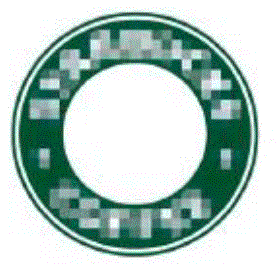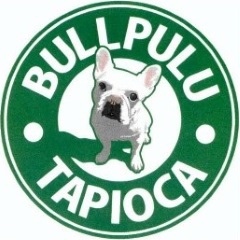The details of the plaintiff's and the defendant's trademarks are shown below.
|
Plaintiff's trademark (4806987) |
Defendant's trademark (5903256) |
|
Mark:
Registration date: 1 October 2004 Owner: Starbucks Corporation Classes:
|
Mark:
Registration date: 9 December 2016 Owner: Kabushiki Kaisha Bull Pulu Classes:
|
The marks differed in appearance as follows:
- The plaintiff's mark contained the words 'STARBUCKS' and 'COFFEE', whereas the defendant's mark contained the words 'BULLPULU' and 'TAPIOCA'.
- Small star devices divided the words in the plaintiff's mark, whereas small circle devices divided the words in the defendant's mark.
- The plaintiff's mark contained a siren device, whereas the defendant's mark contained a dog device.
However, the marks shared:
- the composition of the double green circles;
- the placement of the words; and
- the small devices used to divide the words within the inner green circle.
The main questions in this case were whether:
- the green circle composition (excluding the specific words or devices used in the composition) could be considered well known and characteristic; and
- the characteristics of the composition remained distinguishable in the defendant's mark even where the specific words and devices were replaced with other words and devices.
If so, the defendant's mark would have to be considered unregistrable and the registration would have to be invalidated due to:
- its similarity to the plaintiff's mark under Article 4(1)(11) of the Trademark Act; and
- the likelihood of confusion with the goods or services pertaining to the plaintiff's business under Article (4)(1)(15) of the Trademark Act.
To prove that the green circle composition was well-known and characteristic, the plaintiff conducted a survey through a research company using an image of the composition that had undergone mosaic processing (Figure 1). The survey aimed to determine the percentage of survey participants which were reminded of Starbucks when they saw the mosaic-processed image and therefore to show the degree of image recognition.

Figure 1: mosaic-processed image
The survey involved 552 people aged between 20 and 69 who lived in Japan. It took place over two days (21 and 22 July 2017) and was carried out online.
The survey participants were asked the following three questions:
Question 1:
This image is an extract from a design used by a company in their shops and on goods sold at these shops. The image has been processed, and the original design contains a device at the central part of the image, and, within the green circle, there are words shown in white letters identifying the name of the company. In the processed image, the device has been whited out, and the words have been mosaic-processed so that the company name cannot be read. Please state the name of the company or the shop that comes to your mind when seeing this image. If nothing comes to mind, please state 'none.'
Question 2:
The image in Question 1 is an extract from a design used by a company in the food service industry. Please state the name of the company or the shop within the food service industry that comes to your mind when seeing this image. Because we did not tell you in Question 1 that the company is in the food service industry, it is fine if you state a different name from your answer to Question 1 in your answer to Question 2. If nothing comes to mind, please state 'none.'
Question 3:
The image in Questions 1 and 2 are actually an extract from a design used by a company operating coffee shops. Please state the name of the company operating the coffee shops or the name of the coffee shop that comes to your mind when seeing this image. Because we did not tell you in Questions 1 and 2 that the company operates coffee shops, it is fine if you state a different name from your answers to Questions 1 and 2 in your answer to Question 3. If nothing comes to mind, please state 'none.'
The survey participants were also asked to indicate whether they:
- had visited a coffee shop within the past year; and
- planned to visit a coffee shop within the next year.
The results of the questionnaire survey were as follows:
- 429 survey participants (77.72%) answered 'Starbucks' to Question 1.
- 393 survey participants (71.20%) answered 'Starbucks' to Question 2.
- 463 survey participants (83.88%) answered 'Starbucks' to Question 3.
In all cases, the number of survey participants who answered 'Starbucks' was larger than any of the other answers.
When limiting the answers to survey participants who had visited or planned to visit coffee shops (ie, by deleting the answers of survey participants who answered 'no' to both additional questions), the percentages of survey participants who answered 'Starbucks' were:
- 81.99% for Question 1;
- 76.34% for Question 2; and
- 88.44% for Question 3.
The plaintiff submitted the results of the survey to the Japan Patent Office (JPO) Trial and Appeal Board. However, the JPO Trial and Appeal Board held that the green-circle composition itself was not well known or characteristic and dismissed the invalidation trial. Therefore, the plaintiff filed an appeal (ie, a suit seeking rescission of a trial decision) with the IP High Court.
The IP High Court first noted that the green circle composition was not the actual and specific component of the plaintiff's mark but rather a superordinate concept derived therefrom. The IP High Court stated that it was unlikely that consumers would recognise and remember such a superordinate concept. Based on this view, the IP High Court found that even if the plaintiff's actual mark was well known in its entirety, the superordinate concept (ie, the green circle composition) had not become well known among consumers.
Regarding the questionnaire survey, the IP High Court further stated that where superordinate concepts (eg, the green circle composition) are involved, it is difficult to properly research the degree of recognition and determine whether the superordinate concept itself has gained well-known status. The IP High Court found that the survey in the present case had been performed inappropriately as the questions contained additional explanations of the image – namely, that:
- the original design contained a device at the central part of the image;
- the original design contained words in white letters within the green circle which identified the name of the company; and
- the device had been whited out and the words had been mosaic-processed so that the company name could not be read.
These additional explanations could have influenced participants, leading them to information that was not recognisable or understandable from the image itself.
Therefore, the IP High Court dismissed the plaintiff's appeal.
The plaintiff's and defendant's marks seem broadly dissimilar. Nevertheless, the plaintiff endeavoured to invalidate the defendant's trademark registration by focusing on the commonality of the composition and placement of the double green circles and the words and small devices in the inner green circle.
To prove that the green circle composition was well known and recognised among consumers and that the commonality of the composition would lead to misidentification and confusion, the plaintiff conducted a survey using mosaic-processed images of the green circle composition. The JPO and the IP High Court found that the survey was inappropriate and denied the well-known status of the green circle composition. This case is worth noting for building future strategies in similar cases.







